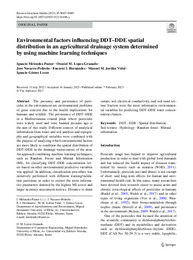Please use this identifier to cite or link to this item:
https://hdl.handle.net/11000/34691Full metadata record
| DC Field | Value | Language |
|---|---|---|
| dc.contributor.author | Melendez-Pastor, Ignacio | - |
| dc.contributor.author | Lopez‑Granado, Otoniel M. | - |
| dc.contributor.author | Navarro-Pedreño, Jose | - |
| dc.contributor.author | Hernández, Encarni I. | - |
| dc.contributor.author | Jordán-Vidal, Manuel Miguel | - |
| dc.contributor.author | Gómez Lucas, Ignacio | - |
| dc.contributor.other | Departamentos de la UMH::Agroquímica y Medio Ambiente | es_ES |
| dc.date.accessioned | 2025-01-16T18:39:24Z | - |
| dc.date.available | 2025-01-16T18:39:24Z | - |
| dc.date.created | 2023-02 | - |
| dc.identifier.citation | Environ Geochem Health (2023) 45:9067–9085 | es_ES |
| dc.identifier.issn | 1573-2983 | - |
| dc.identifier.issn | 0269-4042 | - |
| dc.identifier.uri | https://hdl.handle.net/11000/34691 | - |
| dc.description.abstract | The presence and persistence of pesticides in the environment are environmental problems of great concern due to the health implications for humans and wildlife. The persistence of DDT–DDE in a Mediterranean coastal plain where pesticides were widely used and were banned decades ago is the aim of this study. Different sources of analytical information from water and soil analysis and topography and geographical variables were combined with the purpose of analyzing which environmental factors are more likely to condition the spatial distribution of DDT–DDE in the drainage watercourses of the area. An approach combining machine learning techniques, such as Random Forest and Mutual Information (MI), for classifying DDT–DDE concentration levels based on other environmental predictive variables was applied. In addition, classification procedure was iteratively performed with different training/validation partitions in order to extract the most informative parameters denoted by the highest MI scores and larger accuracy assessment metrics. Distance to drain canals, soil electrical conductivity, and soil sand texture fraction were the most informative environmental variables for predicting DDT–DDE water concentration clusters. | es_ES |
| dc.format | application/pdf | es_ES |
| dc.format.extent | 19 | es_ES |
| dc.language.iso | eng | es_ES |
| dc.publisher | Saltador | es_ES |
| dc.rights | info:eu-repo/semantics/openAccess | es_ES |
| dc.rights | Attribution-NonCommercial-NoDerivatives 4.0 Internacional | * |
| dc.rights.uri | http://creativecommons.org/licenses/by-nc-nd/4.0/ | * |
| dc.subject | DDT | es_ES |
| dc.subject | DDE | es_ES |
| dc.subject | Spatial distribution | es_ES |
| dc.subject | Soil texture | es_ES |
| dc.subject | Hydrology | es_ES |
| dc.subject | Random forest | es_ES |
| dc.subject | Mutual information | es_ES |
| dc.subject.other | CDU::6 - Ciencias aplicadas::62 - Ingeniería. Tecnología | es_ES |
| dc.title | Environmental factors influencing DDT–DDE spatial distribution in an agricultural drainage system determined by using machine learning techniques | es_ES |
| dc.type | info:eu-repo/semantics/article | es_ES |
| dc.relation.publisherversion | https://doi.org/10.1007/s10653-023-01486-y | es_ES |

View/Open:
s10653-023-01486-y (1).pdf
1,6 MB
Adobe PDF
Share:
.png)
